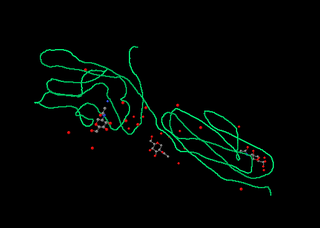
Aldosterone synthase, also called steroid 18-hydroxylase, corticosterone 18-monooxygenase or P450C18, is a steroid hydroxylase cytochrome P450 enzyme involved in the biosynthesis of the mineralocorticoid aldosterone and other steroids. The enzyme catalyzes sequential hydroxylations of the steroid angular methyl group at C18 after initial 11β-hydroxylation. It is encoded by CYP11B2 gene in humans.
In molecular biology, extracellular signal-regulated kinases (ERKs) or classical MAP kinases are widely expressed protein kinase intracellular signalling molecules that are involved in functions including the regulation of meiosis, mitosis, and postmitotic functions in differentiated cells. Many different stimuli, including growth factors, cytokines, virus infection, ligands for heterotrimeric G protein-coupled receptors, transforming agents, and carcinogens, activate the ERK pathway.

CD2 is a cell adhesion molecule found on the surface of T cells and natural killer (NK) cells. It has also been called T-cell surface antigen T11/Leu-5, LFA-2, LFA-3 receptor, erythrocyte receptor and rosette receptor.

Dynactin subunit 1 is a protein that in humans is encoded by the DCTN1 gene.

Platelet-derived growth factor subunit A is a protein that in humans is encoded by the PDGFA gene.

5-hydroxytryptamine (serotonin) receptor 1D, also known as HTR1D, is a 5-HT receptor, but also denotes the human gene encoding it. 5-HT1D acts on the central nervous system, and affects locomotion and anxiety. It also induces vascular vasoconstriction in the brain.
In enzymology, a methionine-tRNA ligase is an enzyme that catalyzes the chemical reaction

5-hydroxytryptamine (serotonin) 1E receptor (5-HT1E) is a highly expressed human G-protein coupled receptor that belongs to the 5-HT1 receptor family. The human gene is denoted as HTR1E.

Keratinocyte growth factor is a protein that in humans is encoded by the FGF7 gene.

MAX is a gene that in humans encodes the MAX transcription factor.

Alpha-centractin (yeast) or ARP1 is a protein that in humans is encoded by the ACTR1A gene.

Neutral alpha-glucosidase AB is an enzyme that in humans is encoded by the GANAB gene.

Transcription factor HIVEP2 is a protein that in humans is encoded by the HIVEP2 gene.

Endosialin is a protein that in humans is encoded by the CD248 gene.

Zinc finger protein 22 is a protein that in humans is encoded by the ZNF22 gene.

Early growth response protein 4 (EGR-4), also known as AT133, is a protein that in humans is encoded by the EGR4 gene.
Parapithecidae is an extinct family of primates which lived in the Eocene and Oligocene periods in Egypt. Eocene fossils from Myanmar are sometimes included in the family in addition. They showed certain similarities in dentition to Condylarthra, but had short faces and jaws shaped like those of tarsiers. They are part of the superfamily Parapithecoidea, perhaps equally related to Ceboidea and Cercopithecoidea plus Hominoidea - but the placement of Parapithecoidea is substantially uncertain.
Plesiopithecus is an extinct genus of early strepsirrhine primate from the late Eocene.
Parapithecoidea is an extinct superfamily of primates which lived in the Eocene and Oligocene periods in Egypt. In some classifications all Parapithecoidea are placed within the family Parapithecidae. Seiffert et al. (2010) propose that Parapithecoidea arose during the Bartonian, with a split between Biretia and the Parapithecidae occurring early in the Priabonian.
Proteopithecidae is an extinct family of primates which lived in the Priabonian and probably early Oligocene periods. Fossils that have been found are in the Jebel Qatrani Formation in Egypt. Currently two genera are recognised, each with a single species, those being Proteopithecus sylviae and Serapia eocaena.














